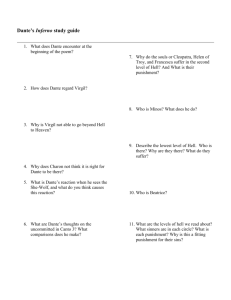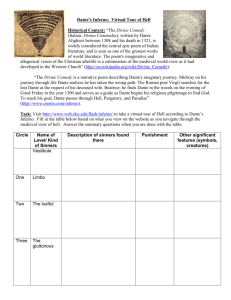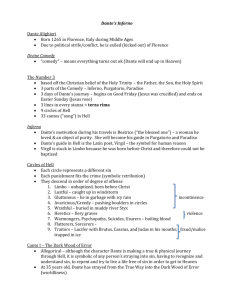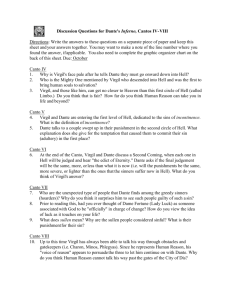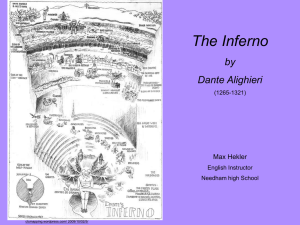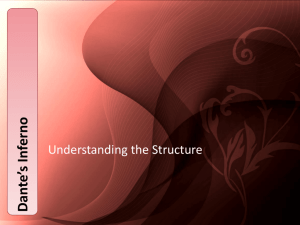Introduction to Dante's Inferno
advertisement
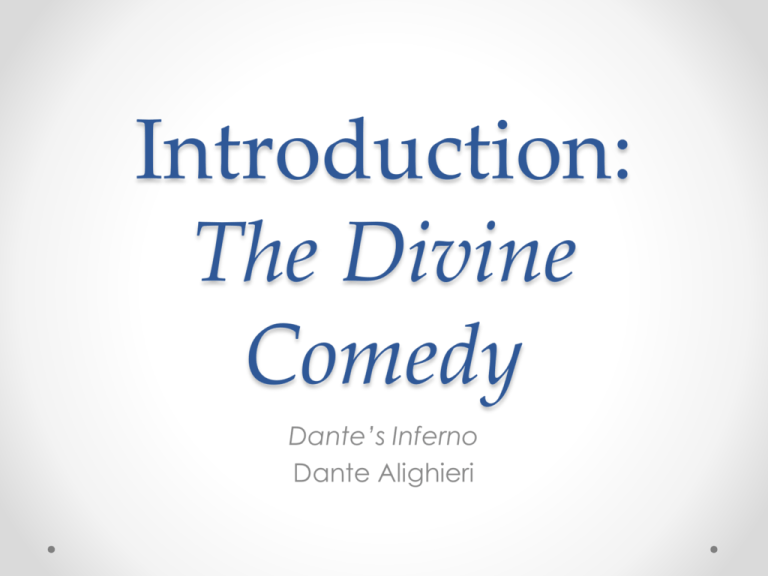
Introduction: The Divine Comedy Dante’s Inferno Dante Alighieri Facts • Written between 1308-1321, by the Italian poet Dante Alighieri • Tells of an imaginary journey Dante takes through Hell, Purgatory, and Paradise. • The journey is symbolic of the spiritual quest for salvation. • This work provides a portrait of almost every aspect of medieval human life. • Dante is the first “Christian Humanist” Dante Dante was a great medieval Italian poet. For Dante, the journey through life meant staying on the straight road to righteousness. • In his Divine Comedy he constructed, by means of literature, his vision of an afterlife, taking into consideration possibilities for all choices of lifestyle. • These included heaven, hell, and purgatory (a place to “work off” sin before entering heaven). • The quest • Recognizing sin (journey through Hell, or the Inferno) • Rejecting sin and awaiting redemption (Purgatory) • Achieving salvation through faith in divine revelation (seeing the light of God in Paradise) o We will just read from the first portion, when he recognizes sin in his journey through Hell Allegory • Defined as: a work in which the characters and events are to be understood as representing other things and symbolically expressing a deeper, often spiritual, moral, or political meaning. o The symbolic expression of a deeper meaning through a story or scene acted out by human, animal, or mythical characters http://www.youtube.com/watch?v=29XBn3M6ZGs An allegory • Dante’s Divine Comedy is based on an allegorical journey. • WARNING!!!! THIS IS VITALLY IMPORTANT INFO o The walk through a dark and confusing world represents the life journey of men and women, who often become entangled in daily affairs and lose their way. • The work assumes two levels of meaning: Temporal (external) and spiritual (internal). • Dante’s extensive literary treatment of death and afterlife aims to both comfort and warn; he envisions rewards for the righteous and doom for the unrepentant. The characters • On his journey, Dante meets many historical figures. Even his guide, the poet Virgil, is an important historical figure. o Virgil- Dante’s guide through the depths of Hell. Historically, Virgil lived in the first century B.C., in Northern Italy. Scholars considered him the greatest of the Latin poets (the Aeneid) o Beatrice: One of the blessed in Heaven, Beatrice aids Dante’s journey by asking an angel to find Virgil and bid him guide Dante through Hell. Like Dante and Virgil, Beatrice corresponds to a historical personage. Although the details of her life remain uncertain, we know that Dante fell passionately in love with her as a young man and never fell out of it. Dante’s imaginary journey throughout the afterlife aims, in part, to find Beatrice, whom he has lost on Earth because of her early death. Critics view Beatrice as an allegorical representation of spiritual love. The characters o Ancient Rome (Virgil would also fall under this category) • Paolo and Francesca da Rimini - A pair of lovers condemned to the Second Circle of Hell for an adulterous love affair that they began after reading the story of Lancelot and Guinevere. o Characters from classical Greek mythology • Charon - A figure that Dante appropriates from Greek mythology, Charon is an old man who ferries souls across the river Acheron to Hell. • Minos - The king of Crete in Greek mythology, Minos is portrayed by Dante as a giant beast who stands at the Second Circle of Hell, deciding where the souls of sinners shall be sent for torment. • Nessus - The Centaur (half man and half horse) who carries Dante through the First Ring of the Seventh Circle of Hell. o Political enemies from his own era • Pope Boniface VIII - A notoriously corrupt pope who reigned from 1294 to 1303, Boniface made a concerted attempt to increase the political might of the Catholic Church and was thus a political enemy of Dante, who advocated a separation of church and state. • Count Ugolino - Italian nobleman, politician and naval commander. He was frequently accused of treason. Found in 9th and lowest circle of Hell. • Archbishop Ruggieri – Betrayed his partner Ugolino. Trapped in 9th circle while getting his head chewed on by Ugolino. The form, numbers, & symbols • The poem contains 100 cantos (chapters/divisions in long poems) • Number 100 regarded as the perfect number in the Middle Ages. • Introductory Canto • The text is divided into 3 sections of 33 cantos Number • The poem is divided into 3 parts: o First- Inferno, focuses on the power of God, the Father. Evidenced by the damned. o Second- Purgatorio, focuses on the wisdom of Christ, the Son, and the hope for salvation that he offers to those awaiting final judgment. o Third- Paradiso. Focuses on the love of the Holy Spirit. Number • The number 3 is important because of its relation to the Christian Trinity. o The Christian doctrine of the Trinity defines God as three divine persons; the Father, the Son (Jesus Christ), and the Holy Spirit. The three persons are distinct, yet are the one “substance, essence, or nature.” • 3 divine figures- Father, Son, and Holy Spirit-in One God. • The poem is divided into three parts: o First- Inferno, focuses on the power of God, the Father. Evidenced by the Time • The journey takes place over 3 days • Begins in Hell on Good Friday, the day of Christ’s crucifixion, and ending symbolically in Paradise on Easter Sunday. Form • A stanza is one of the divisions of a poem, composed of two or more lines, usually characterized by a common patter of meter, rhyme, and number of lines. • The Divine Comedies are composed in tercets, three-line stanzas, and uses a rhyme scheme called terza rima. o The middle of one tercet rhymes with the first and third lines of the next tercet, giving the poem a strong sense of unity. Action • The entire action of the poem takes place under the guidance of three ladies: o The Virgin Mary, the mother of Christ who mediates between God and man. o Saint Lucia, patron saint of Dante and all those without spiritual insight. o Beatrice, Dante’s love, who leads him into paradise. Role of Virgil • Dante’s guide for most of the journey is Virgil, the Roman poet who died 19 years before the birth of Christ. • He explains and instructs • The clarity of Virgil’s mind is contrasted with Dante’s confusion. o “my true master and first author” o “the sole maker from who I drew breath” • Virgil is consigned to the first circle of Hell because he is un-baptized along with the other virtuous pagans from Classical Greek and Rome. A little song to remember…. • http://www.youtube.com/watch?v=DyRaCwgRKXk &feature=youtu.be And now a little “fun” (also see your hand out) • After we view the segment from “Great Books: Inferno,” you will form groups of 4 to create a personal geography of Hell. (You can refer to your handout on the nine circles of Hell so you do not create those!). Your goal is to develop a geography of hell based on your life experiences. • Illustrate! • Choose a guide: write a paragraph explaining why this person was chosen and what are their special talents that make them the perfect guide? • The group must write a paragraph to explain each of the 9 levels of Hell that they create. Include the punishment and sin required for entry.

